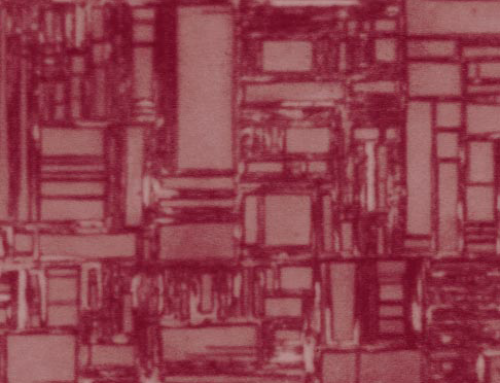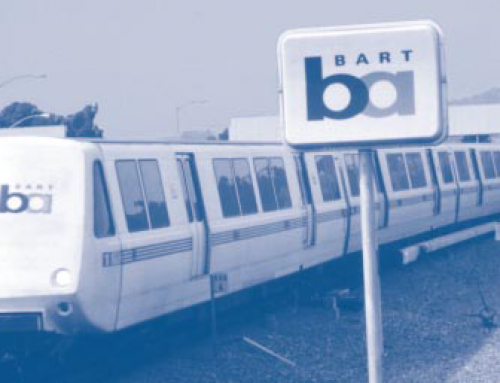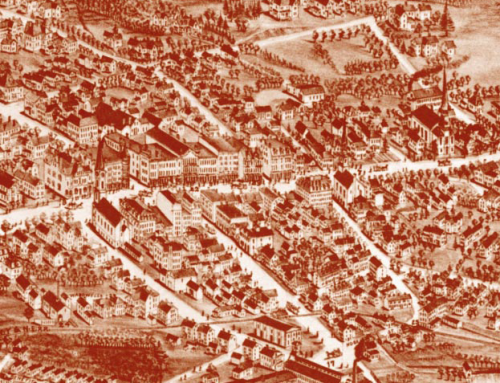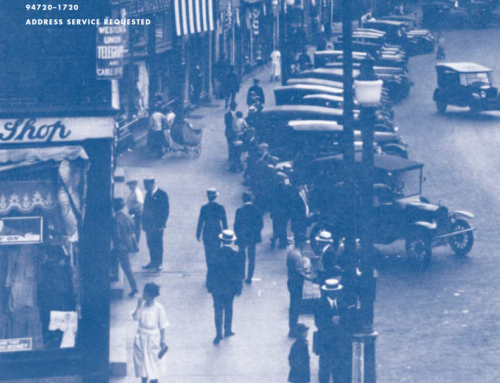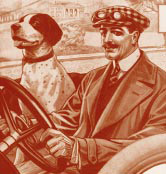 Roads, bridges, gasoline, internal combustion engines, and automatic transmissions were singular advances on the way to modern automobiles. But, without goggles, the horseless carriage might have been slow to arrive. Dust in the eye was objectionable, debilitating, and dangerous at the new high speeds. Whatever access the automobile promised, a driver couldn’t enjoy it if blinded, even momentarily. Developments leading to modern transport systems have been a long series of accommodations to what our eyes can and can’t do. Because future developments must compensate for the limitations of human sight and take advantage of its capabilities, my laboratory has been examining various relations between vision and transportation. Here I’d like to tell about some of those relations.
Roads, bridges, gasoline, internal combustion engines, and automatic transmissions were singular advances on the way to modern automobiles. But, without goggles, the horseless carriage might have been slow to arrive. Dust in the eye was objectionable, debilitating, and dangerous at the new high speeds. Whatever access the automobile promised, a driver couldn’t enjoy it if blinded, even momentarily. Developments leading to modern transport systems have been a long series of accommodations to what our eyes can and can’t do. Because future developments must compensate for the limitations of human sight and take advantage of its capabilities, my laboratory has been examining various relations between vision and transportation. Here I’d like to tell about some of those relations.
Goggles gave way to windshields, but these were no panacea because the heavy windshield frame limited the driver’s field of view. It took a while before slim but strong frames overcame the problem. In 1911 a rearview mirror was fitted to a motor car. This device, an attempt to permit a backward glance, has undergone several developmental changes since then. Modern passenger-side mirrors contrive to expand the field of what’s visible by the simple trick of bending the mirror. But this trick has an unintended consequence: objects in the mirror appear to shrink. Experience has taught our brains that there’s a relation between the size of familiar objects and their distance from us. Shrunken, they appear to be farther away than they really are, hence the warning poem on our side-view mirrors.
Goggles, windshields, and bent mirrors were responses to manifest problems. Future systems will involve new structures dealing with newly perceived optical attributes, including a need for warning signals to alert drivers about stringent road conditions. To increase roadway efficiency, Intelligent Transportation System engineers are now studying plans to shrink lane widths and to equip cars with lane-edge sensors. But, so long as vehicle guidance is under driver control, the driver needs to know when his car crosses the lane’s edge and to act on this information quickly and accurately. That requires improved visual cues.
Reduced headways can also increase efficiency, but that requires a new kind of warning signal that responds to the distance between vehicles. One ITS scheme groups vehicles in compact platoons of twenty or so. Cars in a group accelerate together, change lanes together, and in general behave in a coordinated manner. While under computer control, visual acuity is less crucial. But even then, tomorrow’s drivers will need additional signals to warn that brakes or engine are not up to the demands of coordinated action.
Future systems will involve new structures dealing with newly perceived optical attributes, including a need for warning signals to alert drivers about stringent road conditions.
Warning signals aren’t the only media that will compete for drivers’ attention. The November/December 1998 issue of ITS International showed the following products already available: a microwave pedestrian sensor, a corner sensor to see beyond or beside the front bumper, an in-vehicle computer that displays vehicle performance data, a navigation unit to display real-time alternative route suggestions based on current traffic, a night-vision sensor to display an augmented view of the road that transcends the capability of low beams, navigation aids with fully detailed maps, a birds-eye-view navigation aid, roadside signs with changeable messages, a lane tracker to warn of lane edge crossing, and a red-light violation recorder.
Although many of these innovations do not rely on human vision, other new gadgets will distract drivers’ eyes, compelling one to ask whether the eyes can handle the increased burden. My lab has looked at one small piece of this puzzle. We developed guidelines for constructing display systems for the new warning signals, paying attention to the driving public’s visual attributes, including deficient (though licensable) vision.
As one example, we recommend that movement, not just flickering lights, be incorporated into warning signals. Tests in our lab show that movement improves visibility and reaction time. We also recommend the use of signals in a coordinated system that shows all necessary information in one place. In one implementation, a bird’s-eye view of the vehicle is continuously illuminated, and warnings appear juxtaposed on the outline. A vehicle too close to the lane edge would show an illuminated moving stripe on the appropriate side of the vehicle outline.
Insight on an Escalator
I first became interested in these problems while in Australia. There I was on an escalator descending into the Melbourne airport when I experienced a phenomenon familiar to me as a vision scientist, but not, apparently, to my fellow riders. I sensed that the escalator tread was removed several inches above its actual location. This perception is easily explained as a manifestation of the well-known wallpaper illusion discovered in Europe in the nineteenth century.
Here’s how the illusion works, and how it occurs on escalators. The brain decides where to point the eyes. They are directed to look at the same spot, the angle made by their lines of sight (angle of convergence) indicating the distance of the eyes from that spot. The brain knows the pointing is correct when the images seen in both eyes are essentially the same. An escalator tread looks like a series of dark and light stripes across the visual field. With a periodic pattern like that, the brain can erroneously conclude that two points which only look the same actually 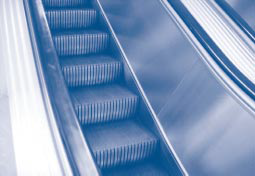 are the same. When that happens the angle of convergence of the eyes is misinterpreted by the brain, and the object seems to be closer to or farther from the eyes than it actually is. An adult looking at a tread underfoot might perceive it as a half-foot closer than it is.
are the same. When that happens the angle of convergence of the eyes is misinterpreted by the brain, and the object seems to be closer to or farther from the eyes than it actually is. An adult looking at a tread underfoot might perceive it as a half-foot closer than it is.
Later measurements in the laboratory at Berkeley and on BART escalators in San Francisco confirmed that depth illusion is triggered by escalator treads and that it can be suppressed by the trick of closing one eye. Many observers find the illusion disorienting and have difficulty standing upright while looking down at the escalator.
Escalators are a principal means for access and egress at urban transit systems. When they stop, they double as stairways. As stairways they leave much to be desired because they sport an unfamiliar riser height that requires the user to look at them, bringing on the illusion.
Ironically, using escalators as advertising media may lower the odds of people falling down. By providing a nonrepeating pattern for the eye to behold, ads appear to have the unintended, but valuable, side effect of reducing the depth illusion. Further measurement will help us to see whether the inadvertent promise of advertisement can be realized.
Large Objects May Be Faster Than They Appear
Around 1984, Hershel Leibowitz at Penn State University was concerned about the alarming number of grade-crossing accidents that occurred when pedestrians or motorists tried to beat the train or simply failed to appreciate its speed. Leibowitz, a psychologist, went so far as to place himself in the engineer’s seat, trying to understand the curious and tragic phenomenon. His understanding of the relation between size and perceived speed led him to conclude that the sheer bulk of the oncoming train fooled observers into thinking it was slow.
You’ve probably observed this phenomenon yourself at an airport. While landing, a 747 or DC-10 looks sluggish in the air compared to a smaller plane landing at a much slower speed. Size is known 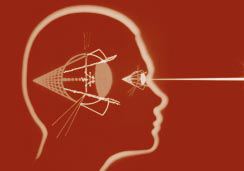 to convey this misimpression, and Leibowitz concluded that at least some grade-crossing accidents could be attributed to the victims’ misjudgment. In the succeeding fourteen years no evidence has refuted his hypothesis.
to convey this misimpression, and Leibowitz concluded that at least some grade-crossing accidents could be attributed to the victims’ misjudgment. In the succeeding fourteen years no evidence has refuted his hypothesis.
Illusion-Free Viewing is Not Good Enough
Leibowitz also contributed important insight to the special perils of night driving. He understood that our eyes are organized around two different visual systems—an ambient system, specialized in processing movement patterns, and a focal system, specialized in detail vision and object recognition. Vehicle guidance depends mostly on the former, and it is remarkably resistant to the effects of lowered light level. Hence, we have little trouble steering a straight course at night.
But hazard recognition depends on the focal system, which becomes far less sensitive at night. Thus, upon receiving reassuring signals from the ambient system, we are lulled into thinking that our sensory system is up to the task of night driving. There is no warning light to tell us that our focal system is impoverished at night and will do a poor job picking out hazards we need to avoid.
We are just beginning to understand properties of the visual nervous system that might affect matters as diverse as speed limits, driver education, and roadway lighting.
A Better Brake Light?
Vision scientists now understand that, in addition to the focal/ambient dichotomy, two independent but cooperating vision systems are at work: the M and P systems. One, termed P system by neurophysiologists, (short for parvocellular, for the neurons to which these cells connect) conveys color and detail information to the brain; it is relatively slow and insensitive. The other, the M system (short for magnocellular), conveys temporal detail, including motion, and is especially sensitive and fast. Armed with this kind of information, designers of transportation vehicles should be better able to exploit the attributes of human vision. Here’s an example:
We’ve developed a new kind of brake light that alerts a fog-shrouded driver when the car ahead applies its brakes. Our idea, which we’ve just begun to test, is that brake lights designed to stimulate the M system will be seen more quickly and more sensitively than lights designed to stimulate the P system. The more important possibility is that, because the M system is so insensitive to spatial detail, it will be relatively resistant to the effects of blur, whether the blur occurs because of the driver’s cataracts, other optical problems like night blindness, or because of a foggy, rainy, or dusty atmosphere.
We’ve made a few laboratory measurements to test this idea. We asked human subjects to imagine they were driving and gave them a “steering” task to reinforce the idea. The steering task consisted of keeping a randomly moving dot within a target circle on a video screen. The dot moved of its own accord, but the test subjects could also move it with the steering wheel. While thus engaged, we asked them to push a button whenever they saw a briefly flashed target, and we interwove a sequence with two different targets for them to detect.
One target was a slightly blurred single blob of light about the size of a brake light. The second consisted of two such blobs ignited in sequence, which thus appeared to move. Both were adjusted in brightness to be just above the limits of detection and so were quite hard to see. We then 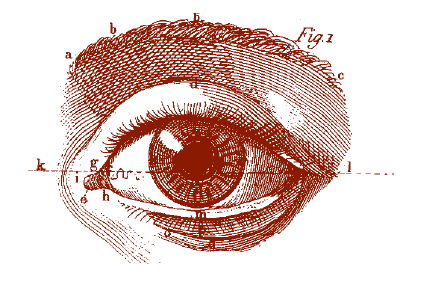 measured the accuracy and speed of signal detection.
measured the accuracy and speed of signal detection.
The moving target was seen about twice as well. Moreover, it was seen more quickly than the stationary target, the difference averaging about 250 milliseconds for our subjects. At 65 miles per hour, a quarter of a second corresponds to a distance of more than one car length. So, if we want to signal a driver following us to stop, this moving target could trigger the stopping response a full car length sooner, perhaps soon enough to avoid a collision. And most important, this advantage is emphasized when onerous conditions of fog or dust make the leading vehicle nearly invisible.
A recent attempt to match brake lights to another aspect of the visual system was not so successful. Based on measurements of where drivers look while driving, researchers thought that a center high-mounted brake light would be likely to fall at the center of a driver’s gaze, making it more easily visible. There was also the extra bonus of the light being visible through the windshield and rear window of an intervening vehicle.
Initial tests on taxicab fleets were highly successful at reducing accidents. Of the roughly 67 percent of rear-end accidents involving braking by the lead vehicle, about half were eliminated in the test fleet. The benefits were calculated to exceed the considerable cost by a factor of ten! Today, one cannot buy an automobile without this now-required apparatus. But the promise of this innovation does not seem to have paid off.
Estimates from different studies place actual reduction in accidents somewhere between 3.5 and 22 percent, still economically useful but nowhere close to initial expectations. Scientists at the National Highway Transportation and Safety Administration are presently trying to audit the entire set of tests to understand why. The lesson they extract will be an important one. Advantages of innovation, however well-planned and conceived, may, unlike objects in the mirror, be smaller than they at first appear!
Licensing
Whether or not Intelligent Transportation Systems mature in the near future, a change in licensing requirements is almost certain. Licensing rules have been remarkable stable: there have been no changes in the vision requirements for licensure in California in over fifty years. Do we need to update these rules to reflect new findings in visual research?
Axiomatically we want licensed drivers to be able to see the road, their destination, and obstacles to their progress. In pursuing that aim, we routinely exclude candidates with visual acuity of less than 20/40. But recent research suggests we’ve been measuring the wrong thing. It now seems that acuity, which gauges the resolution of the eye— that is, its ability to discern fine detail—has too little relation to propensities toward accidents or traffic violations to predict well. Varieties of other vision-performance measures are also unable to predict who will have accidents or commit violations.
Cynthia Owsley and her colleagues at the University of Alabama’s School of Optometry have developed an important new tool, an indicator of vision performance that predicts better than everything else (including the visual acuity that DMVs now rely on) who the good drivers will be. This measure, termed by its inventors the “Useful Field of View,” essentially quantifies the size of the visual field in which sudden events can be discerned by an observer who is already engaged in a task like vehicle guidance. It is essentially a measure of the size of the visual world that drivers are attentive to. The research section of California’s DMV is even now examining the usefulness of this approach in the licensing process. It will be surprising if this does not generate a major change in the way we test vision for licensing in the future.
Vast technological developments are poised to engulf transportation modes in the near future. The changes will be shaped by travelers’ abilities to see and by ways the limitations of those abilities affect their performance as drivers, transit users, or clients of information services. Many of these changes, like objects in our mirrors, are closer than they appear.
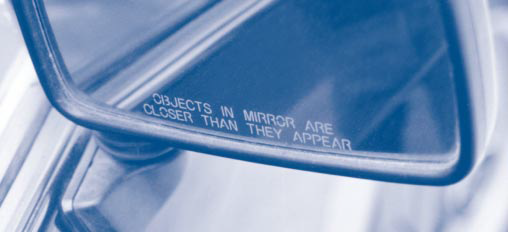
Further Readings
T. E. Cohn and D. J. Lasley, “Wallpaper Illusion: Cause of Disorientation and Falls on Escalators,” Perception 19: 573–580, 1990.
H. W. Leibowitz, “Grade Crossing Accidents and Human Factors Engineering,” American Scientist 73: 558–562, 1985.
Cynthia Owsley, “Visual Attention Problems as a Predictor of Vehicle Crashes in Older Drivers,” Investigative Ophthalmology and Visual Science, 34: 3110–3123, 1993.
R. G. Mortimer, “Center Mounted Brake Lamp: A Cause Without a Theory,” Proceeding of the Human Factors and Ergonomics Society Annual Meeting, 955–959, 1993.


